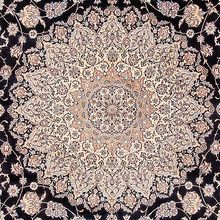Nain Rug
| Nain Rug | |
|---|---|
 Design of Nain Rug (Rugman) | |
| General information | |
| Name | Nain Rug |
| Original name | قالی نایین |
| Alternative name(s) | Nain Carpet |
| Origin | |
| Category | City |
| Technical information | |
| Common designs | Medallion, Afshan, Shah Abbasi |
| Common colors | Cream, Beige, Crimson, Navy Blue, White, Blue |
| Dyeing method | Natural, Synthetic |
| Pile material | Wool, Silk |
| Foundation material | Cotton, Silk |
| Knot type | Asymmetrical (Persian) |
Nain rugs originate from Nain, located in central Iran, just south of Isfahan. Prior to the 2nd World War, Nain was a center of fine textiles. The shift to the production of fine Persian carpets came after the war. Nain rugs are in such high demand worldwide that there are many counterfeits produced in India and Pakistan being sold as authentic. Always purchase from a reputable dealer in order to avoid disappointment. The Habibian workshop is reputed to produce the finest quality Nain rugs. These are very difficult to come by as they are woven in limited quantity. Even more rare is a signed piece. Master craftsmen weave Nain rugs using Persian knots. Experts use a different measurement called LAA, a Farsi word meaning layers, to define the quality of Nain rugs. LAA refers to the number of threads forming each fringe at the end of the carpet. The LAA number on Nain rugs is a good indicator of the price. As the LAA numbers decrease, the price proportionately increases.
History
Nain is a town located in the Isfahan Province of central Iran. In the second quarter of the twentieth century, a number of families from Nain started producing rugs with Isfahan patterns. Prior to this there was no commercial carpet industry in Nain. The designs were similar to the Shrub motifs of Isfahan master weaver Shoreshi that were popular during this period, as well as the traditional Isfahan Shah Abbas designs with palmettes, leaves, and vines in the allover or medallion styles.
Nain weavers are credited with being the first to outline design elements and flowers with silk highlights. This concept was successful and created competition with the popular Isfahan silk foundation rugs. Nains are also known for their light pastel coloration. A typical ivory Nain carpet has limited reds or dark blue in the flowers or other design elements. Light greens, light blues, or light gray are frequently employed for the field. In addition, a mixture of other pastel tones is woven for the borders, flowers, palmettes, and design elements. In general, all Nain carpets have a delicate and muted look. The coloration and use of silk highlights in the design became fashionable, and many looms were added in the town and surrounding areas to weave carpets. Nains were marketed for foreign and domestic high-end consumers. The formats range from small mats and pillows to the rare rugs and carpets in palace dimensions.
Nain rugs and carpets have a cotton foundation, a high-quality wool pile, and silk outlines for the design elements. The Persian (asymmetric) knot is always used. Nain quality is counted by the thickness of the warp in the foundation, with four-, six-, nine-, or twelve-ply used. Four-ply is considered the very finest in quality. The warp is always machine-spun for uniformity. For several decades up until the 1970s, Nain weavers utilized six-ply warps that were fine in quality. The famous Nain master weaver Habibian made the highest-quality rugs using a four- or six-ply warp. His carpets are signed "Habibian," in Farsi, and are considered valuable today.
With the growing demand, Nain manufacturers began to produce and market nine-ply and twelve-ply carpets starting in the last quarter of the twentieth century. They were made for lower-budget consumers with the same coloration and designs, but in a good to very good grade quality. During this period, carpet producers in the town of Nain and the surrounding area were not able to handle the volume of requests of the world market, and Nain carpet producers began to establish looms in other Iranian provinces such as Khorasan, Shahr Kurd Bakhtiari, Yazd, and many other locations to weave Nain style carpets mostly in nine- and twelve-ply qualities to meet the increasing demand.[1]
See also
References
- ↑ Moheban, 2015, 419-420
Bibliography
- Abraham Levi Moheban. 2015. The Encyclopedia of Antique Carpets: Twenty-Five Centuries of Weaving. NewYork: Princeton Architectural Press.